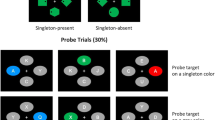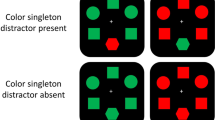Abstract
Researchers have long debated whether salient distractors have the power to automatically capture attention. Recent research has suggested a potential resolution, called the signal suppression hypothesis, whereby salient distractors produce a bottom-up salience signal, but can be suppressed to prevent visual distraction. This account, however, has been criticized on the grounds that previous studies may have used distractors that were only weakly salient. This claim has been difficult to empirically test because there are currently no well-established measures of salience. The current study addresses this by introducing a psychophysical technique to measure salience. First, we generated displays that aimed to manipulate the salience of two color singletons via color contrast. We then verified that this manipulation was successful using a psychophysical technique to determine the minimum exposure duration required to detect each color singleton. The key finding was that high-contrast singletons were detected at briefer exposure thresholds than low-contrast singletons, suggesting that high-contrast singletons were more salient. Next, we evaluated the participants’ ability to ignore these singletons in a task in which they were task irrelevant. The results showed that, if anything, high-salience singletons were more strongly suppressed than low-salience singletons. These results generally support the signal suppression hypothesis and refute claims that highly salient singletons cannot be ignored.




Similar content being viewed by others
Notes
Although we refer to the salience of a distractor, to state the obvious, this salience is with respect to the context provided by a display. For example, a red item might be salient in an otherwise all-blue display but might not be in an otherwise all-pink display.
The floor effect problem refers to the inflation of the per-unit average derived for the nonsingleton distractor condition at higher set sizes. To calculate the per-item average, the total is divided by the number of nonsingleton distractors. Thus, increasing the number of nonsingleton distractors will artificially decrease the per-item average. This makes it difficult to observe suppression below the level of the nonsingleton distractor.
References
Adams, O. J., & Gaspelin, N. (2021). Introspective awareness of oculomotor attentional capture. Journal of Experimental Psychology: Human Perception and Performance, 47, 442–459.
Adam, K. C. S., Patel, T., Rangan, N., & Serences, J. T. (2021). Classic visual search effects in an additional singleton task: An open dataset. Journal of Cognition, 4(1), 34. https://doi.org/10.5334/joc.182
Chang, S., & Egeth, H. E. (2019). Enhancement and suppression flexibly guide attention. Psychological Science, 30(12), 1724–1732. https://doi.org/10.1177/0956797619878813
Chang, S., Niebur, E., & Egeth, H. (2021). Standing out in a small crowd: The role of display size in attracting attention. Visual Cognition. https://doi.org/10.1080/13506285.2021.1918810
Cornelissen, F. W., Peters, E. M., & Palmer, J. (2002). The Eyelink toolbox: Eye tracking with MATLAB and the psychophysics toolbox. Behavior Research Methods, Instruments, & Computers: A Journal of the Psychonomic Society, Inc, 34(4), 613–617.
Cosman, J. D., Lowe, K. A., Woodman, G. F., & Schall, J. D. (2018). Prefrontal control of visual distraction. Current Biology, 28, 1–7.
Cousineau, D. (2005). Confidence intervals in within-subject designs: A simpler solution to Loftus and Masson’s method. Tutorials in Quantitative Methods for Psychology, 1(1), 42–45. https://doi.org/10.20982/TQMP.01.1.P042
Duncan, J., & Humphreys, G. W. (1989). Visual search and stimulus similarity. Psychological Review, 96(3), 433–458.
Folk, C. L., Remington, R. W., & Johnston, J. C. (1992). Involuntary covert orienting is contingent on attentional control settings. Journal of Experimental Psychology: Human Perception and Performance, 18(4), 1030–1044.
Gaspar, J. M., & McDonald, J. J. (2014). Suppression of salient objects prevents distraction in visual search. Journal of Neuroscience, 34(16), 5658–5666.
Gaspelin, N., Gaspar, J. M., & Luck, S. J. (2019). Oculomotor inhibition of salient distractors: Voluntary inhibition cannot override selection history. Visual Cognition, 27(3–4), 227–246.
Gaspelin, N., Leonard, C. J., & Luck, S. J. (2015). Direct evidence for active suppression of salient-but-irrelevant sensory inputs. Psychological Science, 22(11), 1740–1750.
Gaspelin, N., Leonard, C. J., & Luck, S. J. (2017). Suppression of overt attentional capture by salient-but-irrelevant color singletons. Attention, Perception, and Psychophysics, 79(1), 45–62.
Gaspelin, N., & Luck, S. J. (2018a). Distinguishing among potential mechanisms of singleton suppression. Journal of Experimental Psychology: Human Perception and Performance, 44(4), 626–644.
Gaspelin, N., & Luck, S. J. (2018b). The role of inhibition in avoiding distraction by salient stimuli. Trends in Cognitive Sciences, 22(1), 79–92.
Gaspelin, N., & Luck, S. J. (2018c). Combined electrophysiological and behavioral evidence for the suppression of salient distractors. Journal of Cognitive Neuroscience, 30(9), 1265–1280.
Gaspelin, N., & Luck, S. J. (2019). Inhibition as a potential resolution to the attentional capture debate. Current Opinion in Psychology, 29, 12–18.
Greene, M. R., & Oliva, A. (2009). The briefest of glances: The time course of natural scene understanding. Psychological Science, 20(4), 464–472.
Hamblin-Frohman, Z., Chang, S., Egeth, H., & Becker, S. I. (2022). Eye movements reveal the contributions of early and late processes of enhancement and suppression to the guidance of visual search. Attention, Perception, & Psychophysics, 84(6), 1913–1924.
Hauck, C., Lien, M.-C., & Ruthruff, E. (2022). Does superior visual working memory capacity enable greater distractor suppression? Visual Cognition, 0(0), 1–14.
Kaernbach, C. (1990). A single-interval adjustment-matrix (SIAM) procedure for unbiased adaptive testing. The Journal of the Acoustical Society of America, 88(6), 2645–2655.
Kleiner, M., Brainard, D., Pelli, D., Ingling, A., Murray, R., & Broussard, C. (2007). What’s new in Psychtoolbox-3? Perception, 36(14), 1–16.
Kotseruba, I., Wloka, C., Rasouli, A., & Tsotsos, J. K. (2020). Do saliency models detect odd-one-out targets? New datasets and evaluations. ArXiv Preprint ArXiv:2005.06583.
Lamy, D., Alon, L., Carmel, T., & Shalev, N. (2015). The role of conscious perception in attentional capture and object-file updating. Psychological Science, 26(1), 48–57. Psyh. https://doi.org/10.1177/0956797614556777.
Leonard, C. J., & Luck, S. J. (2011). The role of magnocellular signals in oculomotor attentional capture. Journal of Vision, 11(13). https://doi.org/10.1167/11.13.11.
Lien, M.-C., Ruthruff, E., & Hauck, C. (2022). On preventing attention capture: Is singleton suppression actually singleton suppression? Psychological Research, 86(6), 1958–1971.
Loftus, G. R., Johnson, C. A., & Shimamura, A. P. (1985). How much is an icon worth? Journal of Experimental Psychology: Human Perception and Performance, 11, 1–13.
Luck, S. J., Gaspelin, N., Folk, C. L., Remington, R. W., & Theeuwes, J. (2021). Progress toward resolving the attentional capture debate. Visual Cognition, 29(1), 1–21.
Ma, X., & Abrams, R. A. (2023). Ignoring the unknown: Attentional suppression of unpredictable visual distraction. Journal of Experimental Psychology: Human Perception and Performance, 49, 1–6. https://doi.org/10.1037/xhp0001067
Morey, R. D. (2008). Confidence intervals from normalized data: A correction to Cousineau (2005). Tutorials in Quantitative Methods for Psychology, 4(2), 61–64. https://doi.org/10.20982/tqmp.04.2.p061
Nothdurft, H.-C. (1993). The role of features in preattentive vision: Comparison of orientation, motion and color cues. Vision Research, 33(14), 1937–1958.
Ramgir, A., & Lamy, D. (in press). Distractor’s salience does not determine feature suppression: A commentary on Wang and Theeuwes (2020). Journal of Experimental Psychology. Human Perception and Performance.
Sawaki, R., & Luck, S. J. (2010). Capture versus suppression of attention by salient singletons: Electrophysiological evidence for an automatic attend-to-me signal. Attention, Perception, and Psychophysics, 72(6), 1455–1470.
Stilwell, B. T., Egeth, H., & Gaspelin, N. (2022). Electrophysiological evidence for the suppression of highly salient distractors. Journal of Cognitive Neuroscience, 34(5), 787–805.
Stilwell, B. T., & Gaspelin, N. (2021). Attentional suppression of highly salient color singletons. Journal of Experimental Psychology: Human Perception and Performance, 47(10), 1313–1328.
Tam, J., Callahan-Flintoft, C., & Wyble, B. (2022). What the Flip? What the P-N Flip can tell us about proactive suppression. Journal of Cognitive Neuroscience, 34(11), 2100–2112.
Thaler, L., Schütz, A. C., Goodale, M. A., & Gegenfurtner, K. R. (2013). What is the best fixation target? The effect of target shape on stability of fixational eye movements. Vision Research, 76, 31–42.
Theeuwes, J. (1992). Perceptual selectivity for color and form. Perception & Psychophysics, 51(6), 599–606.
Theeuwes, J. (2004). Top-down search strategies cannot override attentional capture. Psychonomic Bulletin and Review, 11(1), 65–70.
Theeuwes, J. (2010). Top-down and bottom-up control of visual selection. Acta Psychologica, 135(2), 77–99.
van Zoest, W., Donk, M., & Theeuwes, J. (2004). The role of stimulus-driven and goal-driven control in saccadic visual selection. Journal of Experimental Psychology: Human Perception and Performance, 30(4), 746–759.
Wang, B., & Theeuwes, J. (2020). Salience determines attentional orienting in visual selection. Journal of Experimental Psychology: Human Perception and Performance, 46(10), 1051–1057.
Won, B.-Y., Kosoyan, M., & Geng, J. J. (2019). Evidence for second-order singleton suppression based on probabilistic expectations. Journal of Experimental Psychology: Human Perception and Performance, 45(1), 125–138. Psyh. https://doi.org/10.1037/xhp0000594
Wöstmann, M., Störmer, V. S., Obleser, J., Addleman, D. A., Andersen, S. K., Gaspelin, N., Geng, J. J., Luck, S. J., Noonan, M. P., Slagter, H. A., & Theeuwes, J. (2022). Ten simple rules to study distractor suppression. Progress in Neurobiology, 213, 102269.
Wyble, B., Callahan-Flintoft, C., Chen, H., Marinov, T., Sarkar, A., & Bowman, H. (2020). Understanding visual attention with RAGNAROC: A reflexive attention gradient through neural AttRactOr competition. Psychological Review, 127(6), 1163.
Yantis, S., & Jonides, J. (1984). Abrupt visual onsets and selective attention: Evidence from visual search. Journal of Experimental Psychology: Human Perception and Performance, 10(5), 601–621.
Open practices statement
All data and stimulus presentation programs in this article are available via the Open Science Framework at https://osf.io/38md9/
Author note
This project was supported by the National Science Foundation Grant BCS-2045624 to N.G.
Author information
Authors and Affiliations
Corresponding author
Additional information
Publisher’s note
Springer Nature remains neutral with regard to jurisdictional claims in published maps and institutional affiliations.
Supplementary information
ESM 1
(DOCX 13 kb)
Rights and permissions
Springer Nature or its licensor (e.g. a society or other partner) holds exclusive rights to this article under a publishing agreement with the author(s) or other rightsholder(s); author self-archiving of the accepted manuscript version of this article is solely governed by the terms of such publishing agreement and applicable law.
About this article
Cite this article
Stilwell, B.T., Adams, O.J., Egeth, H.E. et al. The role of salience in the suppression of distracting stimuli. Psychon Bull Rev 30, 2262–2271 (2023). https://doi.org/10.3758/s13423-023-02302-5
Accepted:
Published:
Issue Date:
DOI: https://doi.org/10.3758/s13423-023-02302-5




